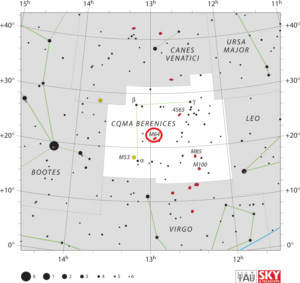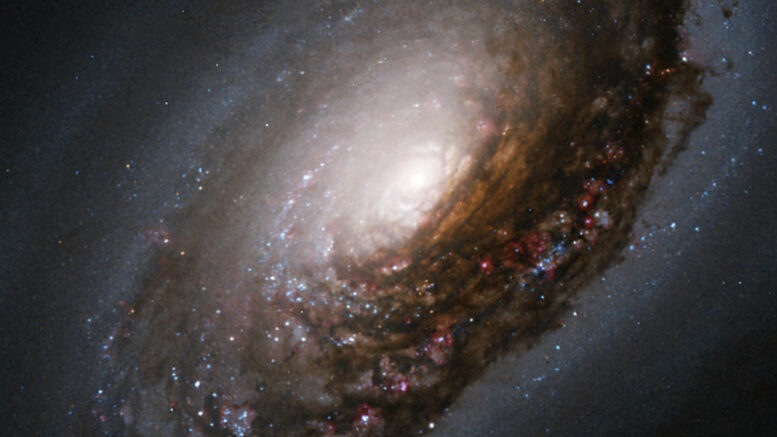Easily identified by the spectacular band of absorbing dust partially obscuring its bright nucleus, M64, or the Black Eye galaxy, is characterized by its bizarre internal motion. The gas in the outer regions of this remarkable galaxy is rotating in the opposite direction from the gas and stars in its inner regions. This strange behavior can be attributed to a merger between M64 and a satellite galaxy over a billion years ago.
| Description | |
| Visible From Pacific Northwest | December to June |
| Best Time To Observe | May |
| Minimum Size Of Viewing Device | Small Telescope |
| Object Type | Spiral Galaxy |
| Designations | Messier 64, M64, NGC 4826, Black Eye Galaxy, Sleeping Beauty Galaxy, Evil Eye Galaxy, PGC 44182, UGC 8062, 2E 1254.2+2157, IRAS F12542+2157, MCG+04-31-001 |
| Right Ascension | 12h 56m 43.7s |
| Declination | +21°40’58” |
| Constellation | Coma Berenices |
| Number Of Stars | 100 Billion |
| Apparent magnitude | +9.36 |
| Apparent dimensions | 10′.71 x 5′.128 |
| Object Radius | 35,000 light years |
| Distance From Earth | 24 million light years |
History
German astronomer Johann Elert Bode discovered M64 independently 12 days later, on April 4, 1779. He wrote, “On April 4 of this year, when I located the comet in the evening north above Vindemiatrix in the Virgin, I have found a small nebulous star, about 1 deg to the northeast near the 35th star of Berenice’s Hair, the longitude of which is about 1 deg [Lib] [181d] and the latitude is 26d north.”
Bode’s discovery was the first to be published, followed by Messier’s, while Pigott’s discovery of the object was largely ignored until Bryn Jones recovered it in April 2002.
Charles Messier found the object on March 1, 1780 and added it to his catalogue as M64, describing it as a “nebula discovered in Coma Berenices, which is about half as apparent as that which is below the hair [Messier 53]. M. Messier has reported its position on the Chart of the Comet of 1779.”
William Herschel was the first to discover the galaxy’s dark band of dust. He was also the one responsible for the name Black Eye. After observing M64 on February 13, 1787, he noted, “A very remarkable object, mE. [much elongated], about 12′ long, 4′ or 5′ broad, contains one lucid spot like a star with a small black arch under it, so that it gives one the idea of what is called a black eye, arising from fighting.”
Locating M64 In The Sky
The Black Eye Galaxy is not particularly easy to find. It is located about a degree to the northeast of the star 35 Comae Berenices, which lies 4 to 5 degrees to the north-northeast of Diadem, Alpha Comae Berenices, a binary star with a visual magnitude that varies from 4.29 to 4.35.
The globular cluster Messier 53 can be found only 1 degree to the northeast of Diadem. Both the cluster and the star lie about 15 degrees to the west of Arcturus, the fourth brightest star in the night sky. M64 lies 19 degrees west and a little north of Arcturus. The best time of year to observe M64 from northern latitudes is during the spring.

Viewing M64
Binoculars reveal only a faint, irregular patch of light, but 4-inch telescopes easily show the galaxy’s large, bright nucleus and if observing conditions are particularly good, its large dark dust lane.
The dust lane is even easier to see in 6-inch telescopes, while 8-inch instruments also reveal the galaxy’s outer regions, which appear as a large halo of wispy nebulosity.
Photographing M64
Messier 64 is an amazing galaxy to image! There have been many online that have shown it is indeed possible to image the galaxy from even from light polluted Bortle 6-7 skies. The larger the telescope the better, as the large the telescope, the greater the detail. Autoguiding will help greatly as well. It is indeed possible to utilize an unmodified DSLR and about 3 hours of exposure to obtain a great image as shown below!
http://www.dl-digital.com/astrophoto/Messier-New/M64-83.html
Sources And Further Reading
Descriptions of all of Messier Objects can be found here.
https://www.messier.seds.org/m/m064.html
https://www.nasa.gov/feature/goddard/2017/messier-64-the-black-eye-galaxy

Be the first to comment on "Messier 64 Black Eye Galaxy"